Observations: The Fellowship of the Ring Movie
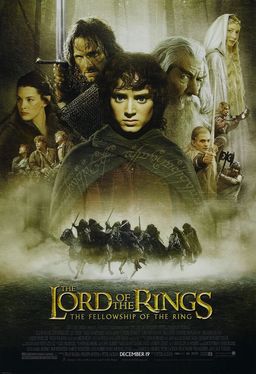 The release of the second installment of The Hobbit got me thinking about The Lord of the Rings movies. And since I hadn’t watched them in a couple years, I decided to pop in my extended version DVDs and re-live what I consider to be one of the best film experiences in my lifetime. I watched with an eye toward what worked for me and what didn’t.
The release of the second installment of The Hobbit got me thinking about The Lord of the Rings movies. And since I hadn’t watched them in a couple years, I decided to pop in my extended version DVDs and re-live what I consider to be one of the best film experiences in my lifetime. I watched with an eye toward what worked for me and what didn’t.
What I won’t be doing in this article is comparing the movies to the books. I love the LOTR books. I’ve read them several times and consider them among the most important novels ever written. However, I want to consider the films on their own, because movies and books are such different media.
So, let’s plunge into the fray. Shall we?
The movie begins with an extended introduction that explains who Sauron is and how he lost the One Ring, how it came into the possession of a furry little fellow named Bilbo. It’s well-done and probably very helpful to those who aren’t familiar with the events in The Hobbit. The highlight to me was when the Dark Lord of Mordor comes out and starts dishing out the pain with a huge mace.
Then we move to the real opening of the story, with Frodo in the Shire. The world of the hobbits is simple and charming, exemplifying a “good life.” I actually forgot how much good stuff happens in these first couple scenes while old Bilbo throws his 111th birthday party. There’s a nice bit of foreshadowing as Bilbo writes his book. He says that there’s always been a Baggins living at Bag End, and there always will be. That little nugget, to me, unlocks one of the powerful themes of the entire franchise: the idea of home as a place in your heart that can see you through the bad times, no matter where you are.
I also loved all the forced perspective used in these movies to show the size difference between hobbits and the taller races. Although easy to miss in the rest of the movie, it really comes through in the Shire scenes, in the interactions between Gandalf and Frodo and Bilbo. Soooooo much better than using CGI for every shot, in my opinion. Oh, CGI has its place and I appreciate it, but there’s something to be said about using other techniques as well.
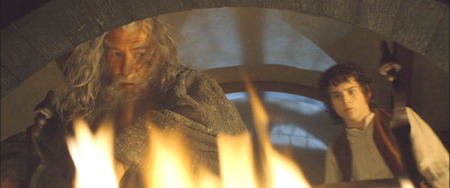 All the scenes at the Shire are golden, but my favorite might be when Bilbo and Gandalf have their last talk at Bag End. There’s so much emotion packed in there, especially when Bilbo struggles to give up the Ring. I love it when he finally drops the Ring and it hits the floor with a thud like it weighs a thousand tons. (Spiritually it does, as we’ll see in the later films.) Of course, here is where Gandalf first suspects that the Ring is important. The film is very clever, focusing on Gandalf’s reaction when Frodo comes in the front door and takes up the Ring. It’s a keen passing-of-the-torch moment that is underplayed magnificently.
All the scenes at the Shire are golden, but my favorite might be when Bilbo and Gandalf have their last talk at Bag End. There’s so much emotion packed in there, especially when Bilbo struggles to give up the Ring. I love it when he finally drops the Ring and it hits the floor with a thud like it weighs a thousand tons. (Spiritually it does, as we’ll see in the later films.) Of course, here is where Gandalf first suspects that the Ring is important. The film is very clever, focusing on Gandalf’s reaction when Frodo comes in the front door and takes up the Ring. It’s a keen passing-of-the-torch moment that is underplayed magnificently.
After a couple scenes, Gandalf returns to the Shire to tell Frodo that his little ring is the One Ring, which the Enemy has been searching for. And Frodo accepts the task of carrying it to Rivendell, which highlights another of Prof. Tolkien’s powerful themes, about the power of a common person with uncommon courage.
A question always nags at me at this point in the story: why does Gandalf leave Frodo and Sam to travel alone? Yes, yes, he wants to consult with his boss, Saruman, but is that really so important that he would leave two hobbits alone on the road with Ringwraiths sniffing around? The best solution I can devise is that maybe Gandalf felt his presence would actually draw attention, while two hobbits alone could pass under the radar, so to speak.
Anyway, Frodo and Sam get moving. They see some elves passing through (I think this is only in the extended version). They hook up with Merry and Pippin, and they run from the Black Riders, which brings them to Bree and the Sign of the Prancing Pony.
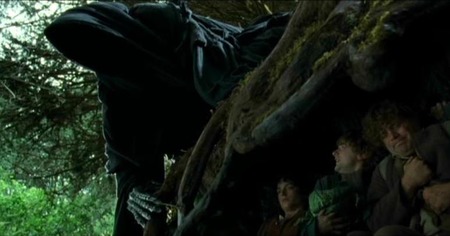 I enjoy this inn because it’s the hobbits’ first experience in the wider world and they’re on their own when Gandalf doesn’t arrive to meet them. I especially like the introduction of Strider (Aragorn) as a scruffy nerf-herder. Er, I mean ranger.
I enjoy this inn because it’s the hobbits’ first experience in the wider world and they’re on their own when Gandalf doesn’t arrive to meet them. I especially like the introduction of Strider (Aragorn) as a scruffy nerf-herder. Er, I mean ranger.
The journey to Rivendell is long and uncomfortable for the hobbits, naturally, but it will seem like a holiday compared to later treks they’ll be taking. When they reach the old watchtower of Weathertop, Aragorn gives the hobbits some swords before he goes to look around. (I miss the barrow-wight scene in the books where the hobbits got their ancient weapons.)
The Black Riders find them, and there is a fight. This is such a cool scene. Frodo puts on the Ring and suddenly he can see the Riders’ true forms, but it doesn’t protect him. In fact, he learns first-hand that the Ring’s power makes him more vulnerable to certain enemies.
This fight is important because Frodo’s courage actually fails him, which is a sign of superior storytelling. I always thought in The Hobbit that Bilbo’s heroism came too easily, but in LOTR Tolkien (and Jackson) make Frodo work for it, which is more satisfying.
Fortunately, Aragorn returns in time to chase away the Riders, though not before Frodo is badly wounded. I found it weird that Aragorn could defeat five Nazgul single-handedly. I understand that it’s required at this juncture of the story, but it makes the Wraiths seem a little weak.
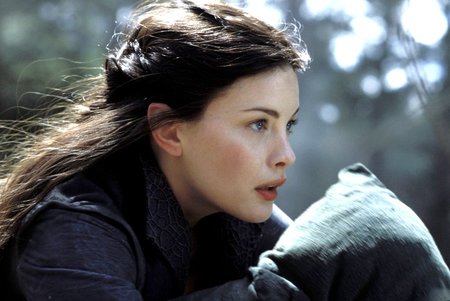 The arrival of Arwen on the road to Rivendell is like a breath of fresh air. I liked how she appeared to Frodo in his weakened state, like an angel. Liv Tyler is wonderfully cast her, giving Arwen the proper ethereal, otherworldly feel.
The arrival of Arwen on the road to Rivendell is like a breath of fresh air. I liked how she appeared to Frodo in his weakened state, like an angel. Liv Tyler is wonderfully cast her, giving Arwen the proper ethereal, otherworldly feel.
The chase where Arwen carries Frodo to Rivendell is just spectacular. Well-shot and superbly executed. It ends with the river rising up (with waves like frothy stallions) to smack down the Black Riders, one of the early highpoints of the movie.
But then we are dropped into a pit of despair as Frodo appears to succumb to his wound and Arwen holds him. Just brilliant.
Frodo awakes in Rivendell, to be reunited with Gandalf and his friends. I’ve got to pause a moment to speak about the setting of Rivendell. It’s even more beautiful in the movie than I imagined when I read the books.
Everything from the long shots showing the grandeur to the closer scenes where we can see the loving detail that went into every column and bannister and chair. The use of real seats and models in these movies is astounding, and something I wish more films would do.
Frodo is later reunited with Bilbo, who is now an old man since he gave up the Ring. It’s a touching reunion as Bilbo passes his sword, Sting, and mithril shirt to Frodo. But then we get a genuinely nasty shot as Bilbo sees the Ring and goes all Gollum-face, showing the depths of the addiction that Bilbo still carries, and always will.
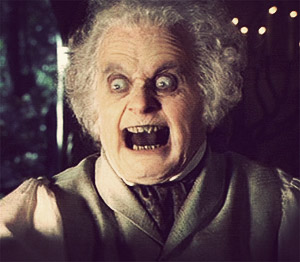 Just as importantly, that shot shows Frodo what he can expect to see in himself if he carries the Ring long enough. It’s a sober reminder to the audience that even though things look rosy here in Rivendell, mortal danger waits beyond the borders.
Just as importantly, that shot shows Frodo what he can expect to see in himself if he carries the Ring long enough. It’s a sober reminder to the audience that even though things look rosy here in Rivendell, mortal danger waits beyond the borders.
At this point, Frodo wants to go home. He thinks he’s done his job getting the Ring to Rivendell and now “important” folk can take care of the problem. The crux of the greater story takes place at the Council of Elrond, where elf lords and dwarf lords and human lords (oh my!) gather to discuss what should be done with the Ring. We also learn that Aragorn is the heir to the throne of Gondor, which prompts Boromir to utter the epic line: “Gondor has no king, Gondor needs no king.”
Elrond and Gandalf convince the council that the Ring must be destroyed in order to defeat Sauron, but the discussion quickly becomes an argument between the races. This scene is a little over-acted, but it’s so much fun (and powerful) that I can overlook it. Frodo steps up and makes the ultimate sacrifice, volunteering to take the Ring to Mordor. Gandalf knows this is the way it must be, but it clearly breaks his heart because he knows what Frodo is going to face. Eight companions volunteer to accompany Frodo. Together they comprise the Fellowship of the Ring.
The journey to Mordor starts off well enough. Everything is casual until the party encounters a flock of crows (crebain) spying for the wizard Saruman. This prompts Gandalf to take them over the mountains through a high pass. There’s a nice scene where Frodo drops the Ring in the snow, and Boromir picks it up. The tension is palpable until he returns, foreshadowing trouble ahead. Saruman sends a blizzard to stop the fellowship, and he and Gandalf duel briefly with their magic. Saruman wins (again) and the fellowship is forced to turn back.
With much dismay, they elect to take the route under the mountains, through the Mines of Moria. Gimli is sure that his cousin Balin will welcome them (Balin having traveled to Moria after the events of The Hobbit to retake the mines from the goblins.) Gandalf is not so sure, believing that Balin’s party may have bitten off more than it can chew.
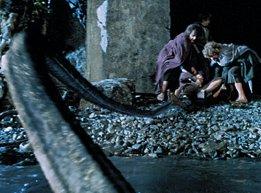 The doors to the mines are beautiful, glowing in starlight, but what I enjoyed most about this scene where they enter is the Watcher in the Water, a giant squid-monster that tries to snatch Frodo. It’s an epic battle ending with the Watcher collapsing the side of the mountain behind the fellowship as they rush inside, trapping them in the mines with nowhere to go but onward.
The doors to the mines are beautiful, glowing in starlight, but what I enjoyed most about this scene where they enter is the Watcher in the Water, a giant squid-monster that tries to snatch Frodo. It’s an epic battle ending with the Watcher collapsing the side of the mountain behind the fellowship as they rush inside, trapping them in the mines with nowhere to go but onward.
Once we get inside Moria, we come to the best part of the movie, in my opinion. The sets are awesome, giving the feeling of being miles underground, both epic and claustrophobic. The movie does a great job of showing how each of the races excels at creating their own versions of beauty, from the elves with Rivendell and Lothlorien, to the dwarves with Moria, and the humans (later in the franchise) with Rohan and Gondor. Just breathtaking.
Now, I know this is slapstick comedy, but I still laugh my ass off every time I watch Pippin knock the bucket and dwarf skeleton down the well. Which, of course, alerts of goblins, and we plunge into another epic battle at Balin’s Tomb. It’s a rush of energy, movement, and terror as the cave troll smashes everything around it. Then Frodo gets stabbed with a spear, and we think he’s dead. Yet he’s saved by Bilbo’s mithril shirt and for the first time earns some genuine respect from the rest of the fellowship.
But all that just sets up the most bad-ass scene in the movie (and maybe all-time): the race for the bridge of Khazad Dum. First, the fellowship is chased by an army of goblins, which is bad enough, but then the Big Daddy comes out. Yes, the freaking Balrog. I remember watching this in the theater and thinking it was the best thing ever. And I still feel that way (perhaps only overshadowed by a few scenes from the original Star Wars movies, but I digress….)
Anyway, the fellowship flees from the Balrog, almost getting squashed by massive crumbling stairs, and Gandalf makes a stand against the demon on the bridge.
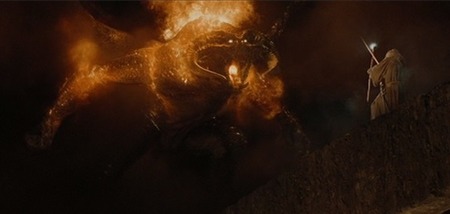 The fall of Gandalf is heartbreaking and depicted so well on screen. Afterward, everyone in the fellowship is numb. Even Boromir is kinder and gentler for a little while. Yet, the show must go on.
The fall of Gandalf is heartbreaking and depicted so well on screen. Afterward, everyone in the fellowship is numb. Even Boromir is kinder and gentler for a little while. Yet, the show must go on.
The company makes its way to the woods of Lothlorien. The elven city is majestic and magical among the trees, strung with ethereal lights everywhere. And Cate Blanchett is marvelous as Lady Galadriel, so regal and mysterious. The scene with her magic mirror and Frodo has an appropriate dream-like quality. I loved how Frodo offers her the Ring, and she is actually tempted, but she rejects his offer and so passes her personal test. As the fellowship departs the woods, Gimli becomes poetic and so finds his way into my heart.
Yet, after Lothlorien, the cracks in the fellowship begin to widen. Aragorn and Boromir argue about the weakness of Gondor. Frodo becomes withdraw as he struggles with what he thinks he must do. Everyone is snapping at each other. All the while, the orcs of Saruman are closing in. Boromir tries to take the Ring from Frodo and fails. Frodo suspects Aragorn will try the same thing, but Aragorn doesn’t succumb to the temptation. That’s when the orcs arrive and chaos erupts. The fellowship battles the orcs while Frodo takes off, intending to leave them behind and go on alone.
Per the battle with the orcs, it’s not quite as awesome as the Balrog battle, but it contains a lot of emotions. I question that Aragorn can engage and hold off the entire orc horde by himself, but I guess if he can defeat five Nazgul single-handedly, these orcs are just a warm-up exercise for him.
Then the others get into the mix. Legolas kicks butt in a spectacular fashion. I’ve heard some criticism that Legolas (and other named elves) are “too perfect.” But here Jackson is really being true to the spirit of the books. Tolkien elevated the elves above all other races. On film, I have no problem with that being depicted as Legolas being able to perform extraordinary feats of agility. He is, after all, superhuman. And his archery tricks are pretty spectacular to watch.
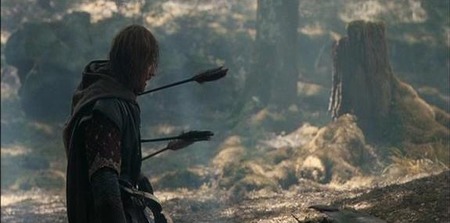 During this battle Merry and Pippin find their courage and help Frodo escape the orcs. And then we have one of the greatest moments in fantasy: the death of Boromir. After trying to take the Ring from Frodo, Boromir races into this fight with something to prove. He fights like a hero should, defending the hobbits until he is shot down by orc arrows. He redeems himself with his valor and sacrifice.
During this battle Merry and Pippin find their courage and help Frodo escape the orcs. And then we have one of the greatest moments in fantasy: the death of Boromir. After trying to take the Ring from Frodo, Boromir races into this fight with something to prove. He fights like a hero should, defending the hobbits until he is shot down by orc arrows. He redeems himself with his valor and sacrifice.
Sean Bean does an inspiring performance in this role. Aragorn may be the one who kills the orc chieftain, but Boromir steals the scene. The shot where Boromir lies on the ground, dying, while Aragorn leans over him, is truly rousing as the two men finally make their peace. It’s a nice touch that Aragorn dons Boromir’s bracers at the end.
The movie ends with Frodo leaving the fellowship. Sam, of course, is willing to drown rather than let him go alone, so Frodo is forced to take his friend along. Frodo and Sam head toward Mordor, while Aragorn, Gimli, and Legolas go to rescue Merry and Pippin from the orcs. And thus we are taken from loss and tragedy to redemption and ultimately to hope – the kind of hope that can only be found in the company of our very best friends.
Watching The Fellowship of the Ring made me fall in love with these movies (and the books) all over again. Middle-Earth is portrayed so lifelike and enchanting that I found myself wishing I could visit, to walk the lanes of the Shire or sit in the house of Elrond, drinking elven wine and listening to the beautiful music. These movies contain every bit as much emotion and poignancy as any “mainstream” drama, but they don’t wallow in it. Instead, these characters keep moving forward, fighting the good fight no matter what odds are stacked against them.
I find that inspiring.
Next week, I take on The Two Towers.
Jon Sprunk is the author of the Shadow Saga (Shadow’s Son, Shadow’s Lure, and Shadow’s Master) and a mentor at the Seton Hill University fiction writing program. His next epic fantasy series begins in March 2014 with Blood and Iron.
Excellent revisiting. I agree with you on just about every point. I could have done without so much of the “superhuman” aspect of the elves, but I understand where it came from. And Borimir’s death chokes me up every single time I watch this film. He is truly Middle-Earth’s Captain America. His only fault is his blind love and devotion to his country.
I need to watch these again myself. Agree that the Balrog is the best thing ever. I do think that there were a few too many “Frodo [nearly] dies in slow motion” scenes in the trilogy, but that’s a minor quibble; I think most of the other weaknesses you point out come from the translation from book to screen, so I’ll just make my peace with them.
And Warner Brothers or somebody _really_ needs to release the Fellowship and Two Towers complete recordings digitally — I’d love the boxed sets, but I’m not paying $3-400 each for a couple of 4-CD recordings.
I’ve been watching these this week, too. My wife and I are watching the extended versions, which means each movie takes a couple of nights to finish, and I expect we’ll start on Return of the King tonight.
A few things about FOTR that stand out to me:
I like that the filmmakers quietly build a connection between Boromir and Merry and Pippin throughout the movie, with him teaching them sword-fighting and joking around and also hugging them protectively when they’re stuck in the snow. Boromir is clearly fond of them and it’s not surprising that he comes to their rescue at the end.
I think my favorite shot in the whole series might be the overhead tracking shot during the climactic orc battle. We start from Aragorn and the others fighting at the top of the mountain, and go all the way down to where Boromir is, and it’s entirely real with no CGI or other tricks.
The Cave Troll is one of the great monsters in the series because of how much personality he shows in relatively limited screen time. Even looking at his appearance basically tells you that the orcs have probably kept him enslaved his whole life and they only keep him around to be used as an oversized attack dog.
I don’t necessarily have a problem with Legolas doing cool stuff in combat, but I do get annoyed with how they increasingly upped the ante on his feats to the point that they began to overshadow other characters later in the trilogy.
This was the best and most perfect of Peter Jackson’s Tolkien films. After it, the magic definitely starting slowly to fade into the West.
I’m with Sarah on this one. I think the first film was the best of the three with Sean Bean’s performance as Boromir being a critical part of the film’s success. For me, I’d cite one other factor. I’d always assumed that – if it was made at all – LOTR would be made either in GB or the states. And I guess I had certain expectations about what kind of film it would be, depending on the location (basically a fruity luvvie-fest if it was made in GB, a western if it was shot in the US, with some John Wayne-type as Aragorn). I think Jackson brought a completely fresh and unorthodox sensibility to the material. It’s easy to forget (because everybody is so familiar with the book) what a very strange film it is – and I mean that in a good way.
[…] Last week I wrote about The Fellowship of the Ring movie, and this week I follow up with the sequel, The Two Towers. […]
[…] about The Lord of the Rings movies with the third installment: The Return of the King (following The Fellowship of the Ring and The Two […]